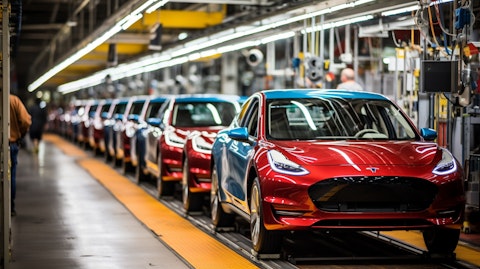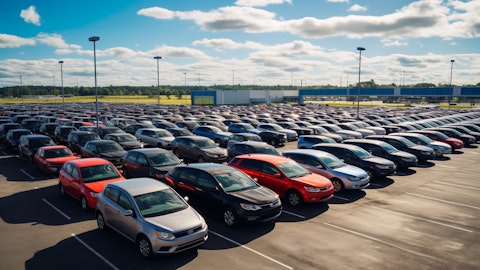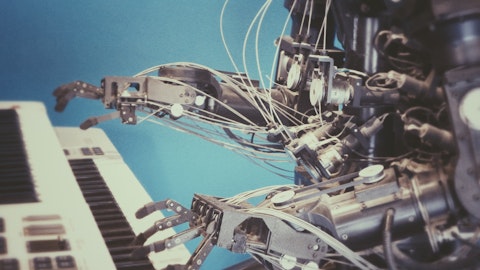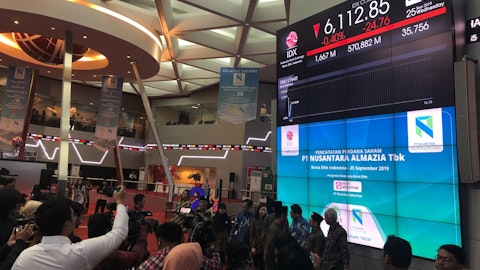SES AI Corporation (NYSE:SES) Q4 2023 Earnings Call Transcript February 26, 2024
SES AI Corporation beats earnings expectations. Reported EPS is $-0.03, expectations were $-0.06. SES isn’t one of the 30 most popular stocks among hedge funds at the end of the third quarter (see the details here).
Operator: Good afternoon, ladies and gentlemen. Thank you for joining today’s SES AI Corporation Fourth Quarter 2023 [Lender] (ph) Call. My name is Tia, and I will be your moderator for today’s call. All lines will be muted during the presentation portion of the call with an opportunity for questions-and-answers at the end. [Operator Instructions] It is my pleasure to pass the call over to Kyle Pilkington, Chief Legal Officer. Please proceed.
Kyle Pilkington: Thank you. Hello, everyone, and welcome to our conference call covering our fourth quarter 2023 results and financial guidance for 2024. Joining me today are Qichao Hu, Founder and Chief Executive Officer; and Jing Nealis, Chief Financial Officer. We issued our shareholder letter just after 4 PM today, which provides a business update as well as our financial results. You’ll find a press release with a link to our shareholder letter and today’s conference call webcast in the Investor Relations section of our website at ses.ai. Before we get started, this is a reminder that the discussion today may contain forward-looking information or forward-looking statements within the meaning of applicable securities legislation.
These statements are based on our predictions and expectations as of today. Such statements involve certain risks, assumptions, and uncertainties, which may cause our actual or future results and performance to be materially different from those expressed or implied in these statements. The risks and uncertainties that could cause our results to differ materially from our current expectations include, but are not limited to, those detailed in our latest earnings release and in our SEC filings. This afternoon, we will review our business as well as our results for the quarter. With that, I’ll pass it over to Qichao Hu.
Qichao Hu: Thanks, Kyle. Good afternoon, everyone. We posted a thorough shareholder letter on our website, which provides all the details for the quarter, the year and our 2024 outlook. Now, I want to make our time more efficient with a more focused conversation. There are three key points that I believe you should think away from SES AI’s results and outlook. First, we became the world’s first to enter into automotive B-sample joint development with a major automaker for lithium metal. This is a major milestone in the commercialization of lithium-metal battery technology for automotive applications. In 2024, our focus will be delivering on our EV B-sample joint development. Second, in addition to EV, we have also identified Urban Air Mobility or UAM as an exciting application for lithium metal.
The high energy density and high power density of lithium-metal really enables UAM. UAM is a natural stepping stone to EV for lithium metal. Third, to ensure practical safety, especially as we prepare for C-sample and commercial deployment, we are doubling down on the use of AI to monitor battery health and predict incident. Our lithium-metal large cell Avatar AI prediction accuracy increased from just 60% in 2022 to 92% in 2023. And this year, our target is 95%. Ultimately, we want to achieve near 100% safety guarantee for EV and UAM. Now I’ll talk more about 2023 accomplishments. 2023 was a great year for us. We took a massive step toward commercialization of our lithium-metal technology for automotive applications. We signed the world’s first automotive B-sample joint development agreement for lithium-metal batteries with a major automaker.
No one has gotten this far with lithium-metal batteries for EV application. This is a giant leap in the commercialization of lithium-metal technology for automotive applications. Our three JDA partners, GM, Hyundai and Honda continue to be very supportive and push aggressively in EV. Hyundai recently just became the second largest EV maker in the U.S. It’s significant to note that two of the key milestones for entering into B-sample development include practical safety and manufacturability. We’ll share more details around these two accomplishments. The first one, practical safety. Achieving hazard level five for large 50 amp hour and 100 amp hour lithium-metal cells was a combination of improved safety in materials as well as improvements in cell design and engineering.
In fact, we achieved greater safety related breakthroughs in cell engineering than in material chemistry. This was intentional because by having minimal changes to material chemistry and by focusing on cell design and engineering, we didn’t have to sacrifice cell performance and energy density. We recruited the world’s top cell engineering talent and created designs that are still based on lithium-ion, so they can be manufactured at scale, but are unique for lithium-metal and can address safety related challenges. We won’t go into details about these cell design and engineering improvements since they are our newest trade secrets, but these new designs, engineering and process improvements are being incorporated into our new B-sample cells.
With regard to manufacturability, we operated three A-sample lines last year. It’s important to highlight that we built more large automotive lithium-metal cells per month in just one line in 2023 than during all of 2022. This was made possible thanks to significant improvements in wide-width thin lithium-metal anode production and anode electro punching and stacking. We made the right decision to move lithium-metal anode production in house. We were able to resolve issues associated with tear, wrinkle and powders much more efficiently. By consistently producing a large quantity of large automotive lithium-metal cells, we generated a large amount of data that we fed our health monitoring and incident prediction Avatar AI model. Prior to 2023, our Avatar AI prediction accuracy was 60%.
By the end of 2023, we are pleased to announce that we achieved 92%. This is important progress. The combination of greater number of cells and greater number of quality control checkpoints per cell was instrumental to the training of our Avatar AI model, making them more accurate. Our training data increased 10x from 2022 to 2023. We’re confident that with more data training and advancement in AI model, we will achieve 95% incident prediction this year and eventually reach near 100% safety guarantee. In 2023, we also laid the foundation for using AI for future roadmap electrolyte development. The goal is to build a roadmap for future generations of lithium metal. Now, switching to our 2024 plans, we expect to make further progress in automotive commercialization of lithium-metal in 2024, and we will focus full stream on our EV B-sample JDA.
We plan to further boost our cell engineering and process development efforts. We’ll continue to improve cell practical safety and manufacturability. We plan to build and operate these sample lines with our JDA partners, potentially one at our own facility and another at our JDA partners’ facility. These B-sample lines will incorporate our latest cell design and engineering as well as manufacturing process improvements. These B-samples lines will also have our latest production quality control plan. We will increase from about 600 checkpoints to about 1,500 checkpoints later this year, including more imaging-based checkpoints such as X-ray, ultrasound, CT and vision. All of these will be fully integrated with our Avatar AI model. This means the amount of training data for AI model will significantly increase in both quantity and quality.

We expect our Avatar AI prediction accuracy to reach 95% for large automotive sales by end of this year. Avatar AI can reach near 100% incident prediction accuracy with sufficient data training. This is very different from today’s lithium-ion quality data, which are still largely based on traditional statistical analysis. And the manufacturing data are decoupled from real-world vehicle data, and very basic models are used to predict incidents. That’s why we still have lithium-ion battery incidents that cost billions of dollars in recall. Our Avatar AI applies a far more advanced AI model that is pre-trained on both lithium-metal and lithium-ion data, and we have access to a comprehensive set of material chemistry data, manufacturing quality data, and real-world vehicle data.
We can achieve near 100% safety guarantee. This near 100% safety guarantee is extremely important for automotive applications and is only possible with advanced Avatar AI. On the use of AI for roadmap electrolyte development, our amazing team of human scientists and AI scientists will work together to systematically study electrolyte chemical structures from public and internal database. We’re very excited to report that we will commission our new Electrolyte Foundry in Massachusetts to focus exclusively on high throughput synthesis and testing of both human and AI generated electrolyte solvent and salt chemical structures. This is a super exciting area. Some pharmaceutical companies have already demonstrated promising signals using similar approach.
However, we are the very first to go this deep in the battery industry, and the signals are very inviting. We know we can accelerate the screening of novel electrolyte candidates. Now let’s see if we can use AI to develop a new electrolyte that’s better than the best ever human-developed one. While we focus on automotive commercialization of current generation of lithium metal, this will help us build a robust roadmap of future generations of lithium metal. In addition to the EV market, we identified Urban Air Mobility, UAM, as a promising and exciting market that is about to take off, especially when powered by high energy density lithium-metal batteries. It’s significant to note that B-sample for EV is equivalent to commercial production for UAM.
For UAM, the energy density and power density of current lithium-ion batteries are too low, and that results in short flight time and limited payload and number of passengers, making the current UAM business not economical. Lithium-metal with about 60% higher energy density will change all that and make UAM a profitable business. The leading UAM companies have been waiting for a lithium-metal company that can produce high-quality, large automotive-grade cells. And 2024 will be a key year for the battery design-in and qualification. And 2025, we’ll see demo flights in major cities such as Seoul, New York City and Abu Dhabi. This is perfect timing for us. We will convert one of our A-sample lines in South Korea to produce exclusively UAM cells.
This will incorporate our latest production quality control plan and be fully integrated with Avatar AI. This line, just outside of Seoul, will have all the quality and engineering improvements of our B-sample lines, but dedicated to UAM lithium-metal cells, modules, and Avatar AI development and production. So, our 2024 goals will include three. First, is focus on EV B-sample. We will work with our B-sample joint development partners to build and operate new B-sample lines. We will improve manufacturing quality control plan from 600 checkpoints to 1,500 checkpoints. Second, is shipped UAM cells. Our UAM cells will be our first commercial products. We will build a dedicated UAM lithium-metal line and ship the first batch of cells to our UAM customers.
Third, is improve Avatar AI incident prediction accuracy. Our ultimate goal is near 100% safety guarantee for EV and UAM applications. In 2024, our goal is 95%. We will finish pre-training our Avatar AI with EV A-sample data and train with new EV B-sample and UAM cell data. These are challenging but exciting goals. Progress in EV B-sample development and shipping the first batch of UAM cells will represent major progress in the commercialization of lithium-metal batteries for EV and UAM applications. Achieving 95% incident prediction accuracy for Avatar AI will represent a major milestone towards the ultimate goal of near 100% safety guarantee, which will be critical for real-world safety. In future roadmap material development, we’re building an AI super scientist.
In cell design and engineering, we’re building an AI super engineer. In manufacturing quality and real-world health monitoring and incident prediction, we’re building Avatar AI, and this information can be used in our supply chain and sustainability management, so we reduce cost and CO2 footprint and build a new supply chain for our EV and UAM customers. At SES AI, our mission is to power a new era of electric transportation on land and in air with lithium-metal batteries. As we build more automotive large capacity lithium-metal cells, generate more data, expand to B-sample and prepare for C-sample and commercial production, AI becomes an increasingly integral part of both material development and battery health monitoring and incident prediction.
Lithium-metal not only leads to longer range and more passengers, but near 100% safety guarantee and accelerated roadmap technology development. We realize that we are building more than just a battery company but the beginning of a superintelligent AI for electric transportation. With that, I’ll pass to our Chief Financial Officer, Jing Nealis, for financial update.
Jing Nealis: Thank you, Qichao. Good afternoon, everyone. Today, I will cover our fourth and full-year 2023 financial results and discuss our operating and capital budget for 2024. In the fourth quarter, our operating expenses were $17.9 million down slightly from the same period last year. Stock-based compensation expense was $4.4 million in the quarter. We reported research and development expenses of $7.4 million. Our gross R&D spending in the fourth quarter was $16.2 million which includes $8.8 million that was billed to our OEM customers and is treated as contra R&D expense. Our G&A expenses were $10.6 million. For the full-year 2023, cash used in operations was $56.4 million and capital expenditures were $15.8 million.
We ended 2023 with $332 million in liquidity. Our strong balance sheet will support the company as we maintain on-track to achieve our commercialization milestones. For the full-year 2024, we expect cash usage from operations to be in the range of $90 million to $100 million and capital expenditures in the range of $20 million to $30 million. We expect total cash usage for the year in the range of $110 million to $130 million. Priorities for 2024 spending are to attract top talent to support the strategic goals Qichao laid out earlier, build production capacities to deliver lithium-metal sales to our EV and UAM partners and invest in the use of AI for electrolyte material discovery as we stay at the forefront of battery material science innovation.
We are very thankful for all the support we have received from our customers, partners and shareholders. With that, I will hand the call back to the operator to open up for questions.
See also Warren Buffett 2024 Portfolio: Top 12 Stock Picks and 15 Countries with Cyber Warfare Capabilities.
Q&A Session
Follow Ses Ai Corp (NYSE:SES)
Follow Ses Ai Corp (NYSE:SES)
Receive real-time insider trading and news alerts
Operator: We will now begin the QA session. [Operator Instructions] The first question comes from the line of Winnie Dong with Deutsche Bank. Please proceed.
Winnie Dong: Hi. Thank you so much for taking my questions. First, I’ve got a clarification. It seems like you’re now, targeting two B-sample lines. I just want to clarify if this is for one JDA partner or if it’s, like, two. I think you’ve sort of hinted at that, in the battery day. And then if you can also remind us, what we could anticipate in the B-sample process and any timeline on with this, when it could potentially conclude? Thank you.
Qichao Hu: Yes, Winnie. So, last year we announced one B-sample, and then so one and then we’re preparing one B-sample line for that B-sample JDA. And then we are working with at least one other OEM carmaker to potentially sign a second B-sample JDA. And, this is why we are preparing a second line. And then later this year, we might end up having two B-sample lines and operate two B-sample lines. And then in terms of timing, we expect the B-sample development will take about 18 months, so this year, 2024, and until, mid next year.
Winnie Dong: Got it. Thank you so much. And then I think some of us may not be, entirely familiar with the UAM application and then the developmental process. Then you mentioned on the, call that, B-sample is actually equivalent to commercial production on that front. So, I was wondering if you can maybe elaborate a little bit more on that, and potentially, disclose how many UAM partners are you actually working with currently? Thanks.
Qichao Hu: Yes. That’s a good question. So with EV, you have this, sort of cliff, basically after B-sample and then C-sample, and then you have to get to at least 10 gigawatt hours, basically, from less than 1 gigawatt hour all the way to 10 gigawatt hour. And then if you don’t have, more than 10 gigawatt hours, then it’s really hard for you to get any meaningful commercial contract. But then for UAM, it’s different because UAM is actually still in the process of ramping up. And then several companies in the UAM, their volume currently are small. We’re talking about single digit number of aircrafts per year. So that’s actually a very good opportunity for us because then our B-sample line, even a fully optimized A-sample line, we can produce at least 1,000 cells per month, and 1,000 cell is about two aircrafts worth of batteries.
So per month, and obviously, considering yields all that stuff, we can make one to two aircrafts worth of batteries. That’s not very meaningful for EV, but then for UAM, it’s actually very meaningful. And then we’re able to supply to them not only for testing, but then later for FAA qualification, certification as well as commercial because EV is already a big market, which we continue to focus on, and that is still the core focus. But in UAM, because it’s a small market and then it’s just ramping up, we can actually ramp up our battery capacity along with UAM ramp up.
Winnie Dong: Okay. That’s very helpful. And then maybe on the CapEx spending of $20 million to $30 million for this year, I was wondering if you can delineate, you know, how much of that goes into automotive versus UAM. I think also for 2023, you’ve ended the year with quite a bit lower CapEx than targeted. So, I guess, what do you think you have spent? And then if you can also comment on maybe, like, the capital efficiency and what’s driving the much lower spending, that’d be helpful. Thank you.
Jing Nealis: I can add on. So to answer your first question, of this year’s guidance, most of the cash is on the EV B-sample line. We are going to spend some money to change one of our current EA-sample lines to be dedicated UAM lines, but that portion of the CapEx is a relatively small portion of the overall CapEx spending. And your second question on last year’s lower spending than our guidance, most of the lower spending is due to just cost control and both have the G&A and some R&D aspect to try to be very prudent with our cash. So a lot of the OpEx part of the thing is permanent. And then on the CapEx side, we were pushing out some of the PO process for the B-sample line that Qichao talked about. So that was a timing issue that was pushed out from last year to this year.
So we’re, placing a PO, we’re still going through the vendor evaluation, process, and we’ll place a PO for the B-sample line this year. So it’s partially timing, but largely, permanent reduction on the cost. Qichao, please feel free to add.
Qichao Hu: Yeah. So the focus is definitely on automotive, and then most of the CapEx this year will be on the building and operation of two B-sample lines later this year. And then for UAM, basically, we’re just taking an old A-sample line and then converting that to UAM. But the focus, all the development, all the new stuff, will definitely take place on the automotive B-sample lines.
Winnie Dong: Got it. Thank you so much for taking my questions.
Operator: We will take the next question coming from the line of Shawn Severson with Water Tower Research. Please proceed. Shawn Severson please verify that you’re not on mute. There are no additional questions at this time. I will pass it back to Kyle Pilkington for any additional remarks.
Kyle Pilkington: Thanks. We did receive a few, pre submitted questions by virtue of a questionnaire we made available to investors ahead of the call. And at this stage, we’ll take a selected number of the, questions which were submitted by investors for our CEO, Qichao Hu. The first question is, when will the first commercial battery production be available on the market?
Qichao Hu: Yes. I think for, UAM, and as we mentioned earlier, UAM is a nice speech at a stepping stone to EV. So for UAM, we’re targeting first half of 2025 next year. And for EV, we’re targeting likely the second half of next year.




